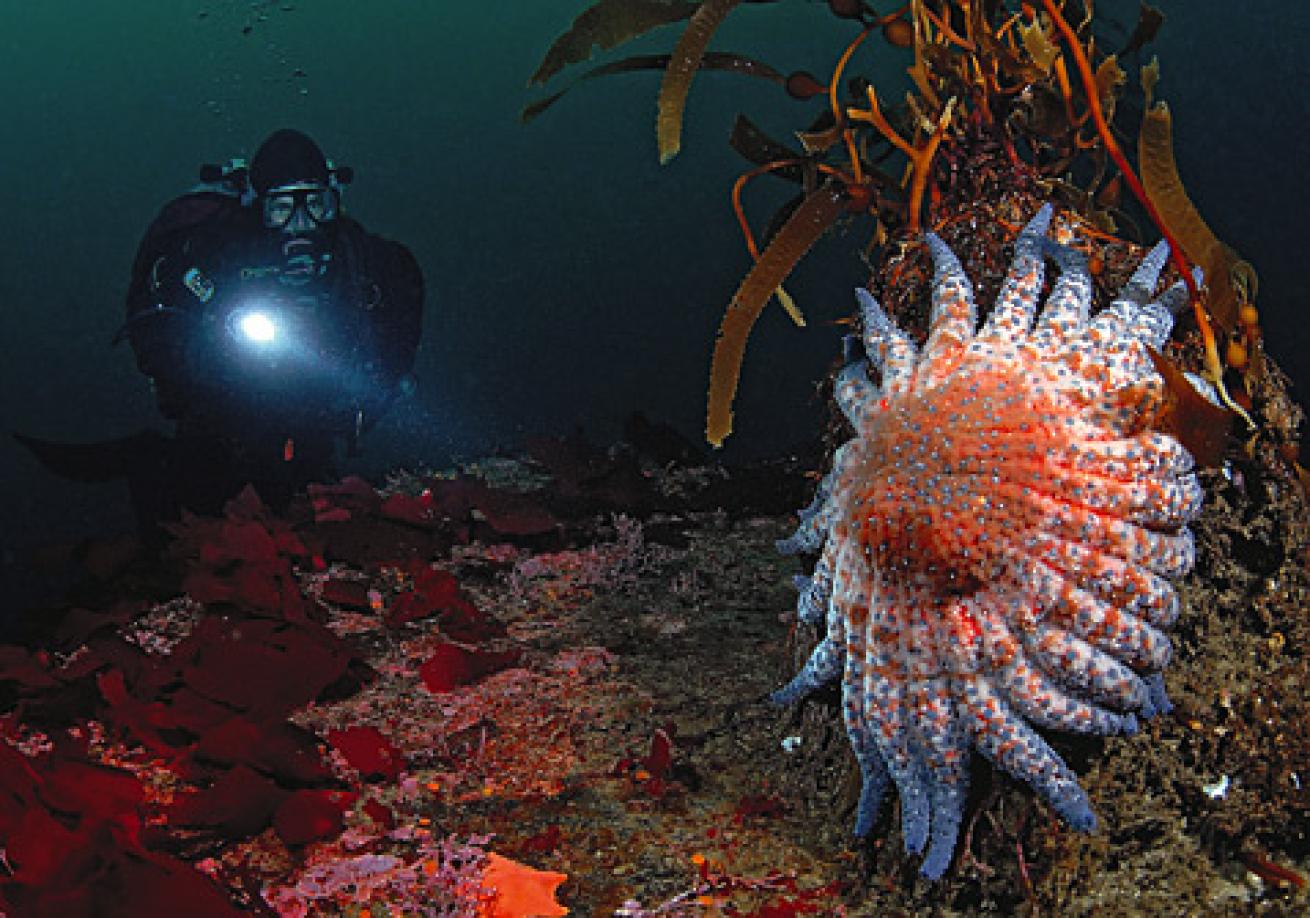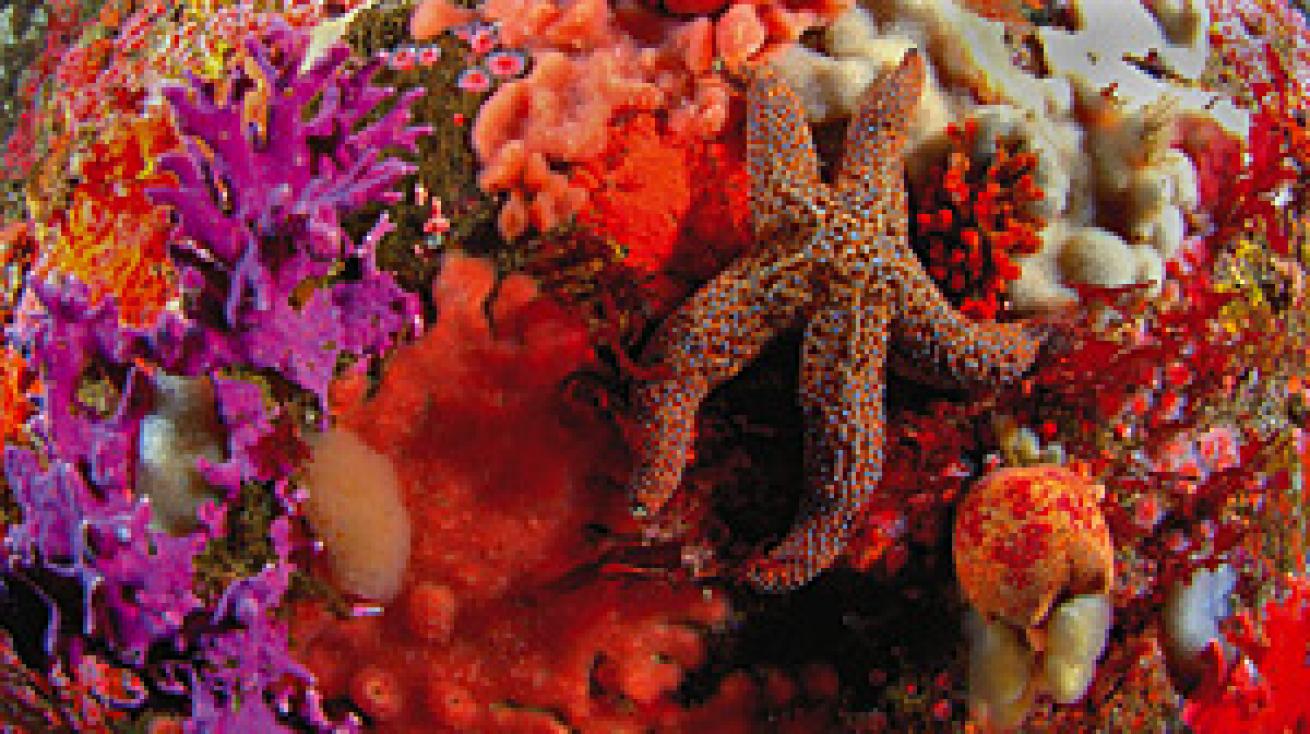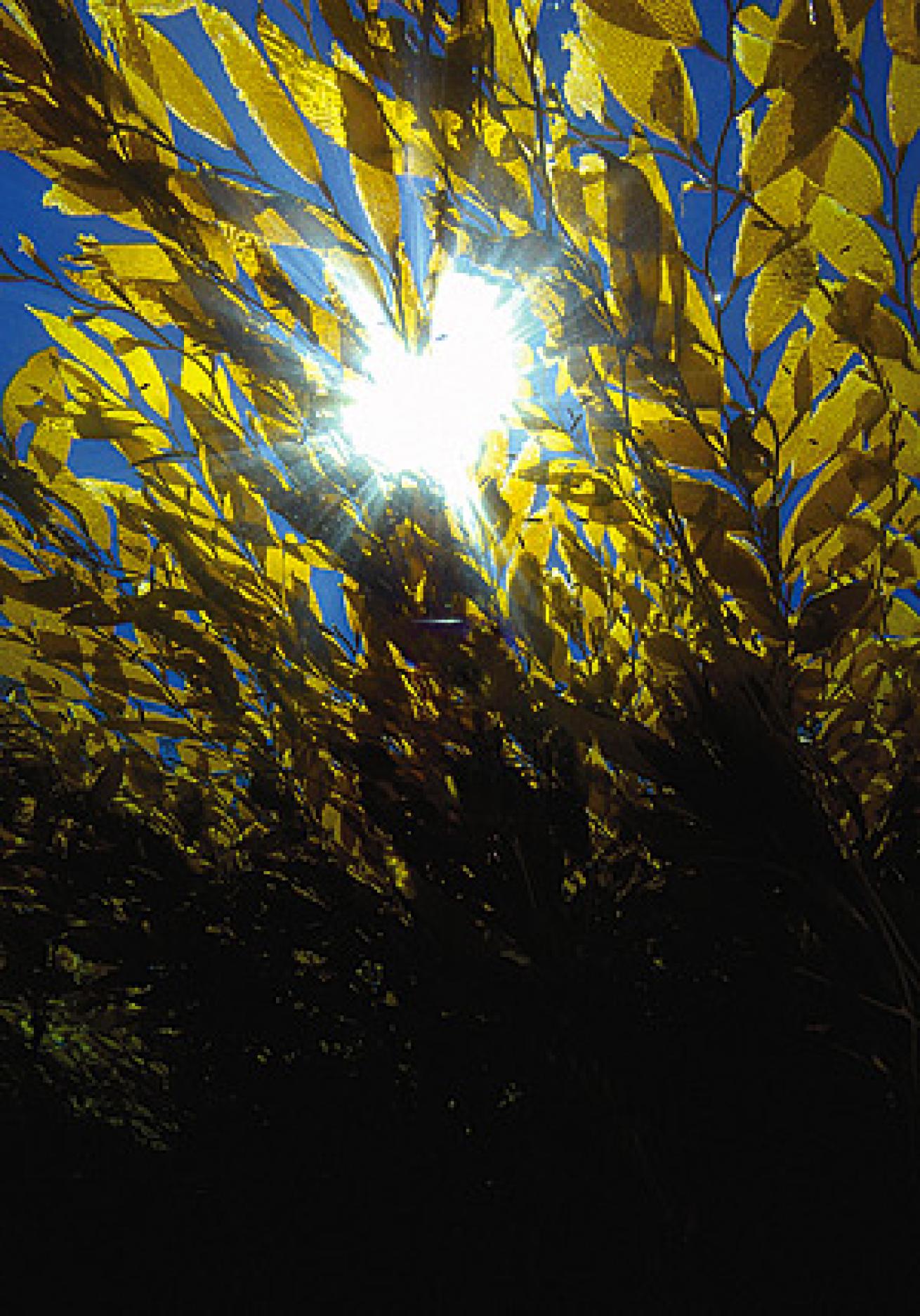Monterey Bay, Calif.

Text by Lauren De Remer
Photography by Joe Dovala
It's 6 a.m. on a chilly summer morning as I suit up for a shore dive at The Breakwater--a manmade site at the U.S. Coast Guard Pier in Monterey. It's the perfect time of day to dive here: the water is calm, the winds are light and the sun is rising to an ideal angle to illuminate the dive site below. And if you're looking for an easy shore dive that showcases the Monterey Bay experience, this is the place. The sand bottom rapidly drops off after I wade in, following the rock breakwater straight out to the site. After a five-minute swim, I'm in the middle of a shimmering kelp forest--a truly wondrous sight.
At 65 feet, I hover over starfish-covered trails that meander through the root-like holdfasts. A kelp rockfish momentarily pauses, staring me down as if it's about to get territorial. Then, a peculiar sound makes me abruptly turn around. It's an otter patrolling the reef, most likely hunting for purple urchins. Sea otters are a rare encounter in other waters, but not here.
With its plentiful kelp beds, seal and sea lion rookeries, nutrient-rich waters, colorful anemones and quality deep dives, Monterey is considered California's best cold-water diving, courtesy of the 10,663-foot-deep Monterey Bay Submarine Canyon. Current upwelling in the canyon sends cold, nutrient-rich water into the bay, fueling an explosion of marine growth. In some areas, depths can ramp up to 300 feet just a few hundred yards from shore. Deep water close to shore means great visibility because of the absence of swells. The vis, colorful flora and fauna, and good weather conditions make The Breakwater and two other spots ideal for first-timers diving Monterey Bay.
Outer Chase Reef
This site, on a reef wall about a quarter nautical mile off shore, consists of rock formations that rise into mountain-like, granite pinnacles, forming crevices and cracks paralleling the shore. There are plenty of fish here, but it's the collection of multicolored anemones and other invertebrate marine life clinging to the rocks that makes it a photogenic site. Depths range between 40 and 80 feet, with the most vibrant areas around 60.
Currents can cause the water to be somewhat murky, and we catch it on a day with about 10 to 15 feet of visibility. Nonetheless, there's still a lot to see. On the descent, I make eye contact with a wolf eel along the vertical wall, mouth wide open in a hole flanked by ochre starfish. At its base, I easily spot a sea cucumber and metridium anemones, followed by large, transparent tube-dwelling ones. In a trench, I find something I've always longed to see: a huge sunflower sea star about 20 inches in diameter. This colorful predator of the seafloor has 22 arms and moves surprisingly fast, munching down on any invertebrate in its path--a sight my eyes and camera can't afford to miss.
Hopkins Reef
This popular spot is so close to shore, you can wave to people peering from the Monterey Bay Aquarium's back deck while you're on the surface preparing to descend. The site lies just inside the boundary of the Hopkins State Marine Reserve but isn't conducive to shore diving. The best way to get here is a short boat ride from Monterey Harbor, but if you're a little more adventurous, you can paddle here by kayak.
Kelp clings to the 10- to 20-foot-high, round boulders scattered about. It's calm at this site--unless the wind and swell picks up--and divers are practically guaranteed encounters with playful harbor seals here because they breed and live in a nearby rookery.
Later, the wind picks up, and suddenly I'm glad I got an early morning start, when the sunlight and calm enhanced my already killer dives. I'm still marveling at the mischievous harbor seals I swam with earlier--how they slowed down and turned their heads toward me, curious about my every move. Those kinds of marine life encounters, the deep dives and the kelp beds truly make Monterey Bay an underwater wonderland.
InDepth
Getting Around: The city of Monterey is a 115-mile, two-hour drive south of downtown San Francisco. Take U.S. 101 South to State Route 85 South, to State Route 17 South, to State Route 1 South to Monterey.
Dive Conditions: Year-round water temps are in the mid to upper 50s at the surface and in the upper 40s to low 50s at depth. Cold-water diving experience is a necessity, and either a dry suit or at least a 7mm thick wetsuit (with gloves, hood and booties) is highly recommended. Visibility generally ranges between 15 and 30 feet and is the most consistent in spring and fall. Topside weather can be deceiving: If it's foggy or stormy on land, it doesn't mean dive conditions will be poor.
Dive Outfitters, Charters and Education Centers: Aquarius Dive Shop (aquariusdivers.com), Cypress Charters (cypresscharters.com) and Monterey Bay Dive Company (mbdcscuba.com) are local operators. Guided tours are available for beginners. Monterey Bay Kayaks (montereybaykayaks.com) offers rentals for divers who want to dive Hopkins Reef without boarding a dive boat. Visit monterey.org for more information.

Text by Lauren De Remer
Photography by Joe Dovala
It's 6 a.m. on a chilly summer morning as I suit up for a shore dive at The Breakwater--a manmade site at the U.S. Coast Guard Pier in Monterey. It's the perfect time of day to dive here: the water is calm, the winds are light and the sun is rising to an ideal angle to illuminate the dive site below. And if you're looking for an easy shore dive that showcases the Monterey Bay experience, this is the place. The sand bottom rapidly drops off after I wade in, following the rock breakwater straight out to the site. After a five-minute swim, I'm in the middle of a shimmering kelp forest--a truly wondrous sight.
At 65 feet, I hover over starfish-covered trails that meander through the root-like holdfasts. A kelp rockfish momentarily pauses, staring me down as if it's about to get territorial. Then, a peculiar sound makes me abruptly turn around. It's an otter patrolling the reef, most likely hunting for purple urchins. Sea otters are a rare encounter in other waters, but not here.
With its plentiful kelp beds, seal and sea lion rookeries, nutrient-rich waters, colorful anemones and quality deep dives, Monterey is considered California's best cold-water diving, courtesy of the 10,663-foot-deep Monterey Bay Submarine Canyon. Current upwelling in the canyon sends cold, nutrient-rich water into the bay, fueling an explosion of marine growth. In some areas, depths can ramp up to 300 feet just a few hundred yards from shore. Deep water close to shore means great visibility because of the absence of swells. The vis, colorful flora and fauna, and good weather conditions make The Breakwater and two other spots ideal for first-timers diving Monterey Bay.
Outer Chase Reef
This site, on a reef wall about a quarter nautical mile off shore, consists of rock formations that rise into mountain-like, granite pinnacles, forming crevices and cracks paralleling the shore. There are plenty of fish here, but it's the collection of multicolored anemones and other invertebrate marine life clinging to the rocks that makes it a photogenic site. Depths range between 40 and 80 feet, with the most vibrant areas around 60.
Currents can cause the water to be somewhat murky, and we catch it on a day with about 10 to 15 feet of visibility. Nonetheless, there's still a lot to see. On the descent, I make eye contact with a wolf eel along the vertical wall, mouth wide open in a hole flanked by ochre starfish. At its base, I easily spot a sea cucumber and metridium anemones, followed by large, transparent tube-dwelling ones. In a trench, I find something I've always longed to see: a huge sunflower sea star about 20 inches in diameter. This colorful predator of the seafloor has 22 arms and moves surprisingly fast, munching down on any invertebrate in its path--a sight my eyes and camera can't afford to miss.
Hopkins Reef

This popular spot is so close to shore, you can wave to people peering from the Monterey Bay Aquarium's back deck while you're on the surface preparing to descend. The site lies just inside the boundary of the Hopkins State Marine Reserve but isn't conducive to shore diving. The best way to get here is a short boat ride from Monterey Harbor, but if you're a little more adventurous, you can paddle here by kayak.
Kelp clings to the 10- to 20-foot-high, round boulders scattered about. It's calm at this site--unless the wind and swell picks up--and divers are practically guaranteed encounters with playful harbor seals here because they breed and live in a nearby rookery.
Later, the wind picks up, and suddenly I'm glad I got an early morning start, when the sunlight and calm enhanced my already killer dives. I'm still marveling at the mischievous harbor seals I swam with earlier--how they slowed down and turned their heads toward me, curious about my every move. Those kinds of marine life encounters, the deep dives and the kelp beds truly make Monterey Bay an underwater wonderland.

InDepth
Getting Around: The city of Monterey is a 115-mile, two-hour drive south of downtown San Francisco. Take U.S. 101 South to State Route 85 South, to State Route 17 South, to State Route 1 South to Monterey.
Dive Conditions: Year-round water temps are in the mid to upper 50s at the surface and in the upper 40s to low 50s at depth. Cold-water diving experience is a necessity, and either a dry suit or at least a 7mm thick wetsuit (with gloves, hood and booties) is highly recommended. Visibility generally ranges between 15 and 30 feet and is the most consistent in spring and fall. Topside weather can be deceiving: If it's foggy or stormy on land, it doesn't mean dive conditions will be poor.
Dive Outfitters, Charters and Education Centers: Aquarius Dive Shop (aquariusdivers.com), Cypress Charters (cypresscharters.com) and Monterey Bay Dive Company (mbdcscuba.com) are local operators. Guided tours are available for beginners. Monterey Bay Kayaks (montereybaykayaks.com) offers rentals for divers who want to dive Hopkins Reef without boarding a dive boat. Visit monterey.org for more information.











